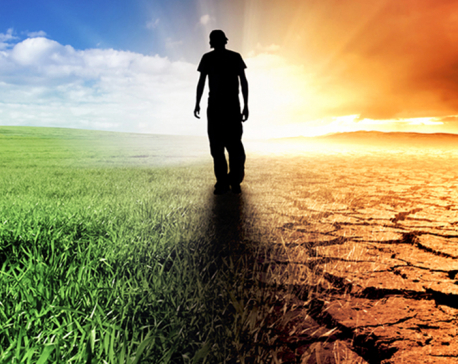
OR
Nepal records rise in annual average temperature
Published On: May 30, 2023 11:30 AM NPT By: Republica | @RepublicaNepal

KATHMANDU, May 30: Nepal is among the countries that are at high risk of climate change due to its geographical topography and geomorphologic characteristics. According to the latest statistics, the annual average temperature of Nepal has increased by 0.056 degrees Celsius.
Due to increasing human activities, the increase in the emission of greenhouse gasses in the atmosphere has led to an increase in global temperature. According to the report of the intergovernmental body on climate change, the average temperature of the earth has increased by one tenth of one degree Celsius compared to 1850-1900.
Nepal has been suffering human and economic losses every year due to climate change disasters. Looking at the trend of greenhouse gas emitted by Nepal from 1990 to 2019, although the growth rate of green gas emission after 2000 is low, it has increased at a high rate after 2008.
Similarly, in 1990, there were 20 million metric tons of greenhouse gas emissions, but by 2019, such gas emissions have reached 48.4 million metric tons, according to government statistics. To address the issue of climate change, the United Nations Framework Convention, the Kyoto Protocol, the Paris Agreement and other structures have been established.
Every country has been formulating policies, laws and procedures to reduce the impact of climate change and implementing them accordingly. According to the Ministry of Forests and Environment, Nepal is also part of these treaties and is working in the field of climate change mitigation and adaptation.
The world's greenhouse gas emissions were 32.52 billion metric tons in 1990, but in 2019, such emissions will reach 49.76 billion metric tons. Between 1990 and 2019, the world's greenhouse gas emissions have increased by an average of 1.45 percent.
According to the statistics of "Climate Watch", the countries that emit the most greenhouse gasses in the world are China, United States, India, and European Union countries, Indonesia, Russia, Brazil, Japan, Iran, Germany and Canada. China has the largest share of the world's total greenhouse gas emissions with 24.2 percent, followed by the United States with 11.6 percent.
The 27th Conference of the Parties to the United Nations Framework Convention (COP) was held in Sharm el-Sheikh, Egypt in 2022. The climate change management division of the ministry said that Nepal has prepared a national concept paper covering the issues of Himalayan region, adaptation, mitigation, agriculture and food security, climate finance, technology transfer and capacity building and submitted it to the conference.
According to the head of the division, Dr. Buddhi Sagar Paudel, in that conference, it was agreed to prepare a report on doubling the adaptation finance for developed countries up to COP-28 on issues such as establishing a damage reduction fund, making institutional arrangements to implement the "Santiago Network".
At present, the climate model program is being conducted at eight local levels to expand the climate model village to more local levels based on the geographical balance and emergency situation in Nepal. In the current financial year, a total of Rs 100 million has been allocated to support the local level in the development of climate adaptation plans.
The share of the budget that directly benefits climate change has been increasing in recent years. In the financial year 2018/19, 4.6 percent of the total budget was allocated for direct benefit of climate change, but by the current financial year, this ratio has increased to 5.9 percent.
According to the crisis and risk analysis report published by the Ministry of Forests and Environment in 2021, there are 24 very high, 26 high, 11 medium, 15 low and one very low districts in the global climate change crisis level. Similarly, according to the report, there are 8 very high, 13 high, 20 medium, 21 low and 15 very low districts at disaster risk level.
You May Like This

Minimizing the Impacts of Climate Change
Climate change poses a grave threat to Nepal due to its geographical location, mountainous terrain, and dependence on climate-sensitive sectors... Read More...

Nepal online trade: Decorating Nepal
Nepal Online Trade is a business initiative of Sajak Yonjan that sells décor materials imported from China, Hong Kong, and... Read More...

Standard Chartered Bank Nepal, Nepal Mediciti join hands
KATHMANDU, Mar 1: Standard Chartered Bank Nepal Ltd (SCBNL) and Nepal Mediciti have signed an agreement to provide various discounted... Read More...





Just In
- CM Kandel requests Finance Minister Pun to put Karnali province in priority in upcoming budget
- Australia reduces TR visa age limit and duration as it implements stricter regulations for foreign students
- Govt aims to surpass Rs 10 trillion GDP mark in next five years
- Govt appoints 77 Liaison Officers for mountain climbing management for spring season
- EC decides to permit public vehicles to operate freely on day of by-election
- Fugitive arrested after 26 years
- Indian Potash Ltd secures contract to bring 30,000 tons of urea within 107 days
- CAN adds four players to squad for T20 series against West Indies 'A'













Leave A Comment